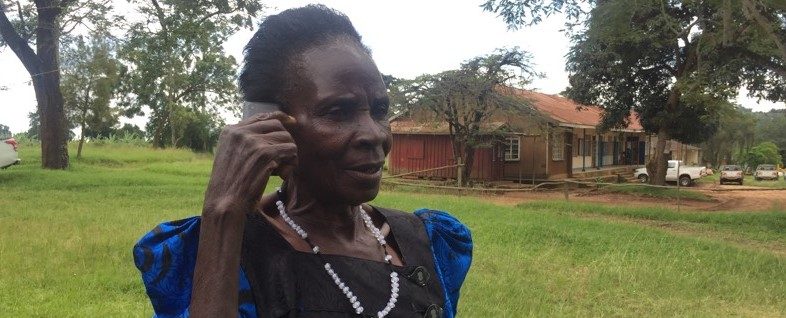Using spot phone calls for measuring gendered time use in rural low-income settings
With social distancing and lockdown measures in many parts of the world, researchers are increasingly looking for methods that do not require travel and face-to-face interactions. Mobile phones are available and affordable in many low-income settings and can support data collection at a distance. Often, use of mobile phones is viewed as a compromise. However, might mobile phones offer advantages compared to other methods of data collection in some settings?
To study unpaid care work and social norms in rural northern Uganda, I used mixed-methods approaches, including surveys (together with Oxfam’s WE-Care Programme), focus groups, interviews and participant observation. But I felt that a longitudinal understanding of time-use patterns was missing. To address this, I piloted the spot phone calls methodology in 2017/2018.
What are spot phone calls?
Together with my research assistant, I called four rural families (each with about six children) over the period of a year. We called at random times every day for a week in three different seasons.
We talked to each household member aged eight and above. We asked participants what they were doing, why they were doing it, what else they were doing at the same time, and what they had planned for the rest of the day. Calls lasted about 5 to 10 minutes.
What worked well?
The spot phone calls worked well at a distance and can be used in times of COVID-19. They exhibited cost and time savings compared to in-person interviews, as I did not have to travel to the field.
In contrast to in-person interview that are often one-off ventures, the calls captured seasonal dimensions of time use. For example, in the dry season, dried-up boreholes had increased women’s and girls’ time spent collecting water.
The calls also showed gendered impacts of household shocks. For instance, I was able to follow up on the impact a father’s injury, with the mother and older girls taking on more income-generating work and children being taken out of school.
The phone calls may have generated more accurate data than some other methods, since respondents were asked what they were doing at a particular moment rather than to recall activities.
Spot phone calls also seemed to better account for men’s care and domestic work that otherwise might have been under-reported because of gendered social norms, but was hard to conceal when asked what they were doing right then. Here is an example from an interview with a man (43 years):
Q. What are you doing? A. I have just finished eating and am resting under a tree.
Q. What did you do before? A. I was working in the garden.
Q. Who is with you? A. My son who is six years old.
Q. What are you doing together? A. We are chatting.
Q. Who cooked your lunch? A. I cooked it myself.
Q. Who fetched water for the cooking? A. I went to the borehole to collect water.
What are the shortcomings?
Like other time-use measures, spot phone calls have pros and cons. We had some technical issues, such as not reaching respondents, phones not being charged, or poor connection.
The sample size was very small. Since not everyone owned a phone in the region, the responses may have been biased. Like in other parts of the world, women were less likely to own or use phones than men, which meant that sometimes I was only able to talk to men.
Calling at random times of the day over a long period may have invaded participants’ privacy and may have made them less inclined to answer the calls.
I was also unable to understand body language and what was going on in the background, for instance, who else was present or listening and how this might have affected the interviewee. This may have limited my understanding of a bigger picture.
Concluding thoughts and lessons learned
Ask probing questions: ‘What are you doing?’ is a good start, but ‘What else are you doing?’; ‘Who is with you?’; or ‘Who cooked your lunch?’ may generate deeper responses.
Conduct background interviews: Conducting background interviews and participating in the daily activities of the families before the calls helped me to understand their situation and to ask relevant questions. In times of COVID-19, one could conduct background interviews over the phone and ask participants to send photos of their daily activities (if they own smartphones).
Continue to ask for consent and consider compensation: We asked for consent before each set of calls and again at the beginning of each call. We provided some household items and airtime for compensation.
Combine spot phone calls with other methods (if possible): On their own, spot phone calls were unable to provide a comprehensive understanding of time-use patterns, but they complemented other research methods, such as a Household Care Survey and participatory workshops.
If you are thinking of using a similar methodology, please have a look at my paper and get in touch at lucia.rost@magd.ox.ac.uk.
Lucia Rost is an independent consultant. She has recently submitted her PhD in International Development at Oxford University, which was related to Oxfam’s Women’s Economic Empowerment and Care Programme.
This story is part of the EnGendering Data blog which serves as a forum for researchers, policymakers, and development practitioners to pose questions, engage in discussions, and share resources about promising practices in collecting and analyzing sex-disaggregated data on agriculture and food security.
If you are interested in writing for EnGendering Data, please contact the blog editor, Dr. Katrina Kosec.
Photo: ILRI/Michel Dione
Exploring spousal disagreement in survey responses, we find that sometimes, sex-disaggregated data may be less useful than many assume.
ANEW will generate evidence on whether and how producer and marketing associations empower women while improving market linkages.
Understanding male engagement in traditionally female domains of domestic work is critically important for the study of agriculture and economic development. New EnGendering Data blog by Jessica Leight.

